It seems the world still can’t get enough of Bruce Lee. On the eve of the 47th anniversary of the martial arts star’s untimely death, Mathew Scott looks for the reasons why.
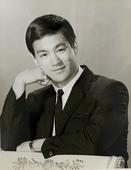 Bruce Lee as a young actor in the United States in the 1960s. (PHOTO PROVIDED TO CHINA DAILY)
Bruce Lee as a young actor in the United States in the 1960s. (PHOTO PROVIDED TO CHINA DAILY)
Bruce Lee’s role as the title character’s sidekick Kato in the American TV series The Green Hornet lasted — like the show itself — for just one season but its impact would alter the course of his life.
The story goes that by the time the series had been cancelled, in 1967, Lee had become increasingly frustrated by the lack of opportunities in Hollywood, and was considering going back home to Hong Kong where he had been a child star — most famous for his role as a plucky orphan in the 1950 hit The Kid. His family was well-connected in the entertainment industry, thanks to his father Lee Moon-shuen, a huge Cantonese opera star.
The thinking was that the connections Lee had been making on the fringes of Hollywood — as a stunt co-ordinator for A-list stars Dean Martin and Sharon Tate on The Wrecking Crew (1968), as he pitched projects to studios, and his fame as a martial arts coach to the likes of actors James Coburn and Steve McQueen — would help open doors back in the city he’d lived in until he was 18.
What Lee didn’t expect, when he walked out of immigration at the old Kai Tak airport back in 1971, was that he’d be greeted by scores of adoring fans. There they were, shouting and calling his name. Despite Lee’s struggles in America, back home in Hong Kong he had already become a star. And that was thanks to the wild popularity of The Green Hornet.
As the charismatic Kato, Lee had flashed glimpses of the easy charm and confidence — and sheer athletic talent — that would later turn him into a global superstar and see his legacy continue to impact on people around the world to this very day, some 47 years after his life was lost to a cerebral edema on July 20, 1973, at age 32.
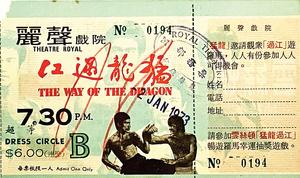 Movie ticket of The Way of the Dragon from 1973. (PHOTO PROVIDED TO CHINA DAILY)
Movie ticket of The Way of the Dragon from 1973. (PHOTO PROVIDED TO CHINA DAILY)
Collector’s items
Ng Kwai-lung was among those whose heads were turned when he first saw Lee in The Green Hornet. Ng would go on to establish a personal trove of Bruce Lee memorabilia, some of which would have featured in The Dragon Never Dies — Bruce Lee @80 exhibition at the Hong Kong Book Fair this week. However, the fair has been rescheduled in view of the escalating third wave of COVID-19 cases in the city.
“The Green Hornet was one of the first dramas broadcast by TVB, launched in 1967,” says Ng, who contends the show inspired the entry of martial art-related content in local comic books “in the 1970s when Brue Lee kung fu movies were very popular in Hong Kong.”
“Hong Kong artists Tony Wong Yuk-long then successfully incorporated kung fu elements into comic books. I had to save pocket money every week to buy the new comic books, which were the start of my ‘idol’ collections.”
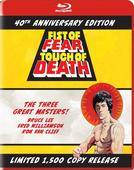 A 40th anniversary edition of Fist of Fear, Touch of Death was released recently on DVD. (PHOTO PROVIDED TO CHINA DAILY)
A 40th anniversary edition of Fist of Fear, Touch of Death was released recently on DVD. (PHOTO PROVIDED TO CHINA DAILY)
New documentary
This year the global spotlight returned to Lee with the screening of the Bao Nguyen-directed documentary Be Water on ESPN. The film charted the course of Lee’s life and spoke to family and friends in an attempt to dig deep into why his star continues to burn so brightly. Reaction to the film — first screened in North America on June 6 — lit up social media around the world as fans discussed Lee’s lasting impact on popular psyche.
In the lead-up to the now-postponed book fair exhibition — which would have showcased Lee in terms of literature, martial arts history and popular culture — Ng was asked to offer his opinion as to why Lee remains such a global force.
“With Bruce Lee, some people like his movies, some prefer his kung fu, and I particularly respect that he integrated martial arts and life wisdom into his personal philosophy,” Ng said. “The spread of these thoughts — through the convergence of movies and kung fu — has affected many people’s life philosophy. He injected his beliefs and patterns into his films, making the films more appealing, and helping them to connect and receive popular acclaim worldwide.”
Ron Van Clief was a young martial artist living in California when he first met Lee — after the star’s ground-breaking display of his martial arts techniques at the 1964 Long Beach International Karate Championships. Van Clief would later become close friends with the “Little Dragon,” and shared dim sum with the star in Kowloon a few days before his death.
“He was a special man,” said Van Clief. “There was just an air about him that drew people towards Bruce. Plus what he said — and what he did with his martial arts — just made a lot of sense to a lot of people.”
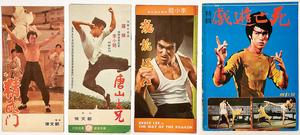 House program booklets of Bruce Lee-starrers Fist of Fury (1972), The Big Boss (1971), The Way of the Dragon (1972) and The Game of Death (1978). (PHOTO PROVIDED TO CHINA DAILY)
House program booklets of Bruce Lee-starrers Fist of Fury (1972), The Big Boss (1971), The Way of the Dragon (1972) and The Game of Death (1978). (PHOTO PROVIDED TO CHINA DAILY)
A spin-off subgenre
On-screen that impact would be felt with the posthumous global box office success of Lee’s Enter the Dragon (US$350 million) but also with the emergence of what’s known as the “Bruceploitation” genre of films. These films — hundreds of them, from the likes of Bruce Lee Fights Back from the Grave (1976) to The Clones of Bruce Lee (1980) — were blatant attempts to cash in on the Lee legacy, mostly by either hiring impersonators such as Bruce Li and Bruce Lei to take the lead, or splicing together old footage of Lee, even outtakes from his movies, to form some kind of narrative.
The genre also speaks volumes about just what a huge star Lee was and continues to be. No other star — in the history of cinema — has a genre dedicated simply to his imitators.
“The genre is so creative, and it comes out of nowhere,” said Ross Chen, a member of the Hong Kong Film Critics Society and founder of lovehkfilm.com.
“That it took off is a testament to how great (Bruce Lee) was because people wanted more from him. You can say that it’s like filmmaking at its most basic. You have an idea, you throw in five fight scenes. Then you have it.”
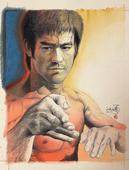 Portraits of Bruce Lee by Yuen Tai-yung from the Hong Kong Book Fair-hosted The Dragon Never Dies — Bruce Lee @80 exhibition. The fair, scheduled to run this week, is temporarily on hold owing to the COVID-19 crisis. (PHOTO PROVIDED TO CHINA DAILY)
Portraits of Bruce Lee by Yuen Tai-yung from the Hong Kong Book Fair-hosted The Dragon Never Dies — Bruce Lee @80 exhibition. The fair, scheduled to run this week, is temporarily on hold owing to the COVID-19 crisis. (PHOTO PROVIDED TO CHINA DAILY)
From the 1970s to the 1980s, Bruceploitation films popped up in markets all over the world to feed a global fan base still desperate to see, or be reminded of, their hero.
“What’s also fascinating is that they were making them before he died,” says Chen. “It was just to feed a short-term market. It’s because he died that it became this long-term thing.”
He feels it would be fascinating to have a symposium critically examining the Bruceploitation genre, given the many twists and turns in its evolution — white actors playing Bruce Lee-like figures in the for example, and raise questions such as, “Does a Bruceploitation film just show Lee’s iconic presence as a person, and a legend, or does it have to be plot-driven around Bruce Lee?”
Contemporary stars such as Donnie Yen — whose recent release Enter the Fat Dragon sees him imitating Sammo Hung imitating Bruce Lee in the 1978 original — continue to tap into Lee as a source of inspiration.
But was it the rise of Jackie Chan that brought the curtain down on the “Bruceploitation” craze?
“They had tried to push him in the West through films like The Protector,” said Chen, of the Hong Kong-US production Chan vehicle released in 1985.
“They couldn’t push his comedy because they thought people overseas wouldn’t accept so it wasn’t until Rumble in the Bronx (1995) that it all changed. And when Jackie Chan became his own thing, with the comedy, that’s about when Bruceploitation ended. When he became the number one martial arts star there was no more need for Bruceploitation. People found a new icon.”
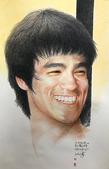 Portraits of Bruce Lee by Yuen Tai-yung from the Hong Kong Book Fair-hosted The Dragon Never Dies — Bruce Lee @80 exhibition. The fair, scheduled to run this week, is temporarily on hold owing to the COVID-19 crisis. (PHOTO PROVIDED TO CHINA DAILY)
Portraits of Bruce Lee by Yuen Tai-yung from the Hong Kong Book Fair-hosted The Dragon Never Dies — Bruce Lee @80 exhibition. The fair, scheduled to run this week, is temporarily on hold owing to the COVID-19 crisis. (PHOTO PROVIDED TO CHINA DAILY)
The enduring mystique
After Lee’s death in 1973, his friend Van Clief would go on to assume the persona of “The Black Dragon” for a series of films of his own, including The Black Dragon’s Revenge (1975). He would also star in the Bruceploitation flick Fist of Fear, Touch of Death — which has just seen its 40th anniversary edition released via Blu-ray/DVD.
Van Clief, now 77 years old and living in Hawaii, said he acknowledged the film’s limitations in terms of quality — it’s set around a fictional martial arts championship, and uses old film and TV stock footage featuring Lee — and pointed instead to the reason, he claimed, people agreed to get involved.
“The film is what they now call a mockumentary but it is also a bunch of people paying tribute to what Bruce Lee was,” said Van Clief. “He was a star.”
Philip Elliott Hopkins is the founder of The Film Detective, a Massachusetts-based internet television service and vintage film archive and the company behind the anniversary edition of Fist of Fear, Touch of Death.
“It’s a cockamamie movie but somehow despite all the chaos, it worked in a very weird way,” he said. “Growing up I would see these posters or Bruce Lee movies. You’d see the picture of Bruce Lee, you know about Enter the Dragon and who he is, but then you realize that it is really not a Bruce Lee movie. It’s a Bruceploitation movie.
 A scene from the 1980 film, Fist of Fear, Touch of Death, made by putting together bits from old Lee films and new footage featuring Lee lookalikes. (PHOTO PROVIDED TO CHINA DAILY)
A scene from the 1980 film, Fist of Fear, Touch of Death, made by putting together bits from old Lee films and new footage featuring Lee lookalikes. (PHOTO PROVIDED TO CHINA DAILY)
“It’s completely exploiting his popularity and trying to ride off this deception. But they are also a tribute to what a star he was, and there’s never been a genre dedicated to one star like this one is.”
American filmmaker Michael Worth has spent the past decade piecing together a book on the Bruceploitation genre, and the past two years helping put together a documentary on the subject currently undergoing final edits.
For the final word on the theme that the world continues to be fascinated by the man, look no further.
“He was a talented martial artist, no doubt about it, but what was much more striking was his charisma,” said Worth. “He’s very hip. He’s got this swagger to him. He was a hit. Then, like James Dean, he was gone.
“But Bruce Lee had also disrupted martial arts with his ideas, and no one could quite work him out. A lot of what the Bruceploitation genre was about was trying to unravel the mystery of Bruce Lee. It’s something we are still trying to do today.”


